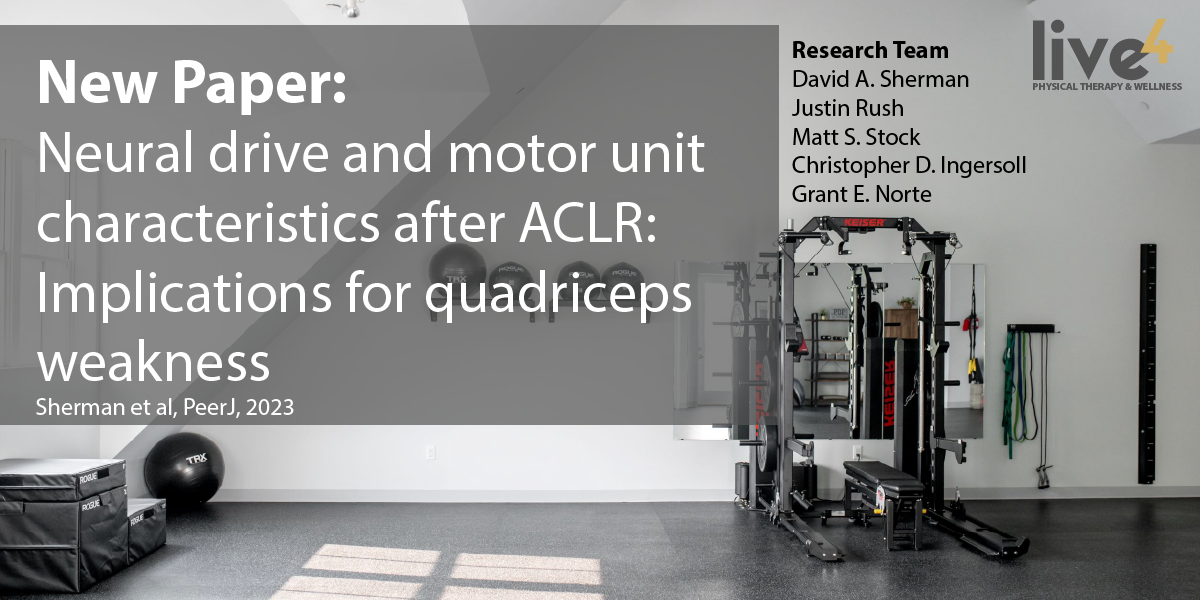Neural drive and motor unit characteristics after ACLR: Implications for quadriceps weakness
My colleagues and I have new paper out in PeerJ.
Why exam the quadriceps motor neuron pool?
Persistent quadriceps weakness remains the hallmark clinical impairment following anterior cruciate ligament reconstruction (ACLR).
Quadriceps weakness is highly predictive of both poor self-reported function and irreversible osteoarthritis. Current clinical practice strategies fail to restore adequate quadriceps function despite targeting strength training after ACLR.
Muscle function depends on the quality of neural drive to the muscle.
The resultant muscle output is determined in part by the recruited motor units’ (MU) properties. Specifically, force output is highly dependent on the summation of the size, firing rates, and recruitment thresholds of the recruited MU within the muscle. Fewer available MU, due to arthrogenic muscle inhibition, may limit neural recruitment strategies to perform quadriceps strengthening exercises. A previous study reports reduced neural drive may explain less ability to upregulate motor unit firing rates after ACLR.
We aimed to compare quadriceps motor unit behavior, motor neuron pool excitability, and volitional activation between individuals with ACLR and controls.
In healthy muscle, larger MUs with lower firing rates are recruited as volitional torque output increases creating negative (MUAPAMP-RT) and positive (MFR-RT) linear relationships respectively. Considering the extent of quadriceps weakness, inhibition, activation failure, and atrophy after ACLR, a better understanding of the relationships between MUs size, firing rate, and RT with respect to quadriceps motor neuron pool excitability and voluntary activation following ACLR will inform rehabilitation practices.
On the basis of prior work, we anticipated that quadriceps strength and voluntary activation would be lower in the ACLR limb, yet motor neuron pool excitability would be normal. We hypothesized that individuals with ACLR would demonstrate faster MU firing rates and smaller MU action potential size with increasing volitional torque output. We also hypothesized that they would recruit motor units along a narrower range of torques in the involved compared to uninvolved and control limbs.
Methods: Hoffmann Reflex, Superimposed Burst, and Motor Unit Decomposition
Hoffmann Reflex and Superimposed Burst Technique
We assessed motor neuron pool excitability (spinal reflex inhibition) and volition activation in all participants. Learn more about how here.
Motor Unit Decomposition
Participants performed multiple repetitions of a force tracing task while electrical activity from the quadriceps were recorded. We motor unit action potential spike trains are then identified and we examine the linear relationship between firing rates, action potential size, and recruitment thresholds.
All individuals in our sample has normal reflex excitability and volitional activation.
The ACLR group was similar with respect to neural drive to the quadriceps motor neuron pool from a spinal reflex excitability stand point. They also activated a normal proportion of their motor units during MVIC (~95%).
Weaker quadriceps, from slower motor units of similar size.
The ACLR limb was far weaker compared to uninvolved limb (3.0 vs 3.5 Nm/kg), which was accompanied by a smaller range of RTs, slower MU firing rates, and larger MU action potentials during 70% and 100% MVIC contractions.
Fewer and slower motor units.
A limited ability to recruit and upregulate the firing rates of motor units, resulting in fewer active motor units that fire more slowly at given force outputs.
Shorter recruitment range and slower motor unit firing rates at given recruitment thresholds suggests an inability to upregulate MU firing rates may account for reduced quadriceps force generating capacity. As inhibition was not influencing motor unit behavior in this sample, we speculate that the neural deficit of the involved limb in this sample is the result of reduced cortical drive, rather than alterations in spinal reflexive circuits.
Implications: Is motor unit catabolism limiting quadriceps muscle capacity after ACL injury?
A MU consists of an alpha motor neuron and all the muscles fibers it innervates. In healthy muscle tissue, MU are homogenous of type I or type II muscle fibers. Following ACL injury, inhibition may reduce the number of neuromuscular junctions and denervate muscle fibers within the involved quadriceps muscle. Reduced excitability of the motor neuron pool and inability to recruit MU severely limit the ability to engage the muscle during exercise. Without training, catabolism of non-activated (inhibited) motor units may occur with exposure to catabolic substances, such as inflammatory cytokines. This may result in successful reconditioning and habituation of small amplitude, low-threshold MUs of predominantly type I fibers, while larger amplitude, high-threshold MUs of predominantly type IIa fibers remain untrained despite rehabilitation. These findings suggest that some individuals may not be able to regain function of all motor units. In other words, the ceiling of quadriceps muscle function is lowered.
The Full Text
The full paper is available online at PeerJ, or download the pdf here.
You can also reach out to me on ResearchGate.
Citations
Norte et al., 2018
Øiestad et al., 2022
Lisee et al., 2019
Lepley et al., 2015
Pietrosimone et al., 2022
Noehren et al., 2016
Hunt et al., 2022
Lepley et al., 2020
1 - Nuccio et al. J Physiol. 2021.
2 - Bodkin et al. Clin Biomech. 2021.
3 - Luc et al. J Electromyogr Kinesiol. 2016.
4 - Pietrosimone et al. J Electromyogr Kinesiol. 2015.
5 - Lepley et al. J Strength Cond Res. 2012.
6 - Norte et al. J Sport Rehabil. 2021.





